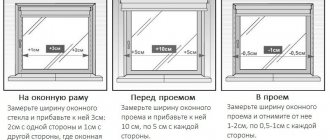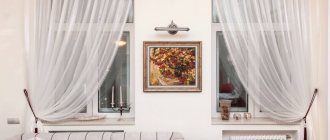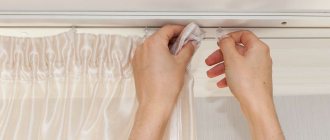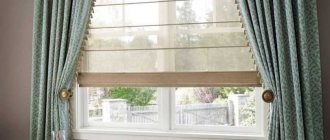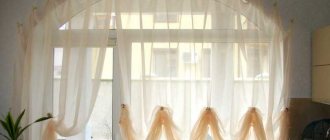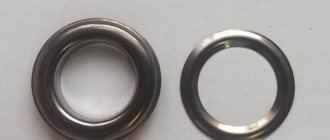Welcome to Furniture&Textiles. This article provides a little guidance on determining the width and length of your curtain. It must be remembered that one of the first and important steps when choosing curtains is determining the correct and exact sizes of future curtains.
To select the size of curtains, you first need to take measurements of the cornice, window, window sill and measure the distances from them to the walls of the floor and ceiling. To take more accurate measurements, use a metal tape measure. It holds its shape well and will allow you to take measurements without distortion.
It is advisable to have a tape measure at least 5 meters long, so that when measuring you do not measure long distances in parts. Now let's take a closer look.
How to take measurements to choose curtain size
To determine the size of your curtains, you first need to determine which curtain rod you will use and where the curtain rod will be located. This is important because we will take subsequent measurements from the cornice.
Take a tape measure and take measurements as shown in the picture. Don't forget to write down all readings. Take measurements to the nearest centimeter.
So:
- Measure the length of the curtain rod. (In fact, this will be the width of the window plus the indents on both sides of the window borders on which the cornice protrudes.) Measure the length of the cornice, within the limits of the curtain rod hangers, since the curtain fabric will not extend beyond them. If you have a different type of curtain rod and the curtain can move along its entire length, measure the full size. Let's call this size the Working length of the cornice.
- Measure the distance from the cornice to the floor
- Measure the distance from the eaves to the top edge of the window sill
Bedroom placement
Bedroom decoration should create an atmosphere of relaxation. Curtains on the window perform not only a decorative, but also a protective function. They prevent the penetration of daylight, drafts or street noise. The best choice would be a canvas made of dense material. It can be velvet or brocade.
In order to soften the overall composition, soft flowing tulle is suitable.
The standard length of curtains from the floor largely depends on the location of the window opening. If the window sill is located above the head of the bed, you should choose the short option. A long product will be pressed against the back of the bed, which will lead to rapid deterioration of the material.
Advice. Roller curtains are suitable for this bedroom layout.
The size of the room can also be visually adjusted by choosing the right shade.
For a small space, curtains decorated in cold or pastel colors are suitable. The finished composition will expand the total area and lengthen the walls. It is better to choose cold colors for a large, spacious bedroom.
Note. The window can be decorated with one curtain measuring 300 by 300 cm.
How to calculate the length of curtains
Calculating the length of curtains depends on three main factors:
Select the type of curtain length you want
To choose the right curtain length, you will need to determine what type of curtains you will use in your room. The following are the main types of curtains depending on their length
- Standard long curtains , the size of this type of curtain is equal to the distance from the cornice to the floor minus 1-2 centimeters
- Extended curtains , the size of this type of curtain is equal to the distance from the cornice to the floor plus 20-30 cm.
- Short curtains , the size of this type of curtain is equal to the distance from the cornice to the top edge of the window sill
Determine the type of fastening of curtains to the cornice
Another element that affects the length of the curtains is the type of fastening of the curtain to the curtain rod.
- If you use curtain fasteners in the form of loops or hooks, then the length of the curtain should be measured taking into account the height of this fastener. In the version with loop fasteners, the total length of the curtain fabric should be reduced by the size of the loops.
- If eyelet rings are used as fasteners, then the size of the curtain fabric should be reduced by the distance of the eyelets from the top edge of the curtains.
The figure shows curtain fasteners in the form of loops and in the form of eyelet rings
Thus, the total length of the curtain will be equal to the length of the curtain fabric plus minus the length of the curtain fastening element.
Consider the length allowances for curtains
When purchasing fabric for curtains, do not forget to provide allowances of 5 cm for the top and bottom edges of the curtains for processing and hemming the edges. The top and bottom edges of the curtains must be hemmed, otherwise the fabric of the curtains may unravel and become “shaggy.”
What is needed for accurate measurements
When taking measurements, many people make standard errors. It is important to eliminate errors, and the panel should cover the baseboard or even touch the floor covering with its edge.
The fabric is calculated for each individual element, and then everything is summed up and the footage is obtained, which will be correct for a particular option.
Even in panel houses, walls sometimes have curvature and height deviations in the corners. To do this, you need accurate measurements on both sides of the wall on which the cornice is. The difference usually does not exceed 1 cm, but there are deviations of up to 5 cm, although this cannot be determined visually.
Tip: To determine the average length of the curtain, hang a weight on a rope (plumb line) from the extreme point of the cornice. First on one side, then on the other, assessing the difference along the control line of the intended curtain. We derive the arithmetic average (add both measurements and divide in half).
It is always recommended to take into account the composition of textiles and carefully read the label, since natural components shrink by at least 10%.
Batteries, balcony doors, and some decorative elements in interior design make it difficult to take accurate measurements. A plumb line is the best way to accurately determine the correct size of a product.
Another important point is what the measurements are used with. You can use:
- an ordinary school ruler, if nothing else is at hand;
- a measuring tape (colloquially “centimeter”);
- measuring tape.
A tape measure is preferred because it has the greatest length and does not twist or bend like a tape. With it, you do not need to summarize several measurements into a total footage, as with the use of rulers.
Light textiles drape in waves, while denser materials form clear folds, which should not be too many.
Important! Curvature or difference in height of the walls can be detected after sewing the curtains. Removing and altering them, leveling 1-2 cm, will be very difficult. It will take a lot of time and effort. It is much easier to interrupt the cornice by slightly moving one edge higher or lower.
Errors in width are also possible. It is easier to eliminate them by using a universal construction level with laser markings. Along the intended line, mark with a pencil and measure with a ruler the minimum width, to which allowances are added, a small margin in width for the removal of the baguette rod, for lush folds, etc.
The width of the selected fabric and the placement of the picture on the canvas play a primary role in calculating fabric consumption.
You will need a notepad for notes - it is easy to lose the sheet. Be sure to mark, for example, “measurements for the bedroom window” or “curtains for the living room” so as not to be confused. You should not calculate in your head and keep the parameters in your head, especially when you have to put off work for a while.
If you have to calculate the flow rate taking into account various coefficients, a calculator will come in handy. At the same time, it is easier to calculate the approximate cost of window decoration - cornice plus fabric, threads and fittings.
When the pattern is directed along the roll, its maximum width coincides with the maximum width of the finished curtain.
How to calculate the width of curtains
The width of the curtain depends on the width of the window and the length of the cornice. But in order to choose the right width of curtains, you need to decide on the number and volume of ruffles on the curtains. The splendor of the curtain and the number of folds on it mainly depends on your preferences, but there are also accepted standards that allow you to make the curtains look neat and harmonious.
Choosing the width of the curtain depending on the type of fabric
There is a concept of curtain puffiness, which determines the number of folds on the curtain fabric along its width.
Depending on the type of fabric, different pomp is recommended.
To calculate the total width of the curtain, depending on the type of fabric, the pomp factor (Kp) is used.
To determine the width of the curtain taking into account the type of fabric you need to:
Multiply the working length of the cornice by the pomp factor.
Fluff factor depending on fabric type
- For dense heavy fabrics Kp=2
- For medium density fabrics Kp=2.5
- For light, low-density fabrics Kp=3
In the photo there is a curtain made of thick corduroy Kp = 2
In the photo there is a medium density curtain Kp=2.5
The photo shows examples of light curtains Kp=3
Selecting the width of curtains depending on the number of folds
Here are some tips for choosing the width of the curtains and selecting the number of folds on the curtains
- When choosing drapery, consider the volume of the room in which the curtains will be used.
- Very lush curtains will look intrusive in a small room.
- You should not make a lot of folds on curtains with a pronounced pattern.
- Consider the style of the interior. Do not use lush curtains in minimalist and high-tech interiors
In the photo above and below are examples of curtains with a pronounced pattern.
To determine the width of sliding curtains, you can use the following table
| Cornice length | Curtain width |
| Cornice no more than 1.4 m. | The width of the panel is equal to the length of the cornice |
| Cornice no more than 2.0 m. | The width of the panel is equal to 1.5 times the length of the cornice |
| Cornice no more than 2.8 m. | The width of the panel is equal to 2 lengths of the cornice |
| Cornice no more than 3.4 m. | The width of the panel is equal to 2.5 lengths of the cornice |
| Cornice no more than 4.0 m. | The width of the panel is equal to 2.5 lengths of the cornice |
Using the table, you will get the required total width of the curtains. Keep in mind that the total width assumes the width of all curtains - after all, curtains can consist of several curtain panels.
In the case when you do not want folds on the curtain fabric at all, the width of the curtains will be equal to the length of the curtain rod.
Curtain width allowances
As a rule, curtain fabrics already have edge processing on the sides. But if you are using a different type of fabric, then do not forget about an additional 5 centimeters from each edge of the curtain for processing and hemming.
Extended models
Some people like the curtains to be 15–20 cm longer than usual. They are tied up beautifully, each fold is carefully laid out on the floor, emphasizing the beauty of the fabric or unusual design.
Custom length curtains
But this is more of a decorative technique than a working curtain. It is appropriate in large rooms with open space and is not suitable for small rooms where such a length will only get in the way.
I have a negative attitude towards this method of decorating windows. No matter how beautiful it looks in the picture, using such a curtain is inconvenient. It cannot be closed/opened, otherwise you will immediately ruin the beauty of the folds, it interferes with cleaning, the bottom part collects dust, and gets dirty on the floor.
Choosing the length and width of curtains depending on the type of room
Now I will present short recommendations for choosing the size of curtains depending on the type of room where we will use them
Choosing the size of curtains for the kitchen
Length and width of curtains in the kitchen. Since there are many sources of pollution in the kitchen - grease, steam and other delights, for easier care of curtains it is preferable to have curtains with a small area of contamination. Curtains up to the length of the window sill and with a minimum number of folds in width are suitable for this criterion, optimally - smooth, read in width equal to the length of the cornice. Of course, if you are not afraid of more frequent washing of curtains, then you can choose long and more draped options.
Choosing the size of curtains for the living room
- Curtains for the living room in length . Classic floor-length curtains will look good in the living room. That is, the length of the curtains is equal to the distance from the cornice to the floor, plus or minus the fastening of the curtains.
- Curtains in the living room in width . The width depends on the size of the room and the style of the interior. If the living room is in classical styles, then draping the curtains is acceptable, which means the width of the curtains can be calculated according to the table given above. If the interior is in a modern style, for example, the interior is in a minimalist style, then the width of the curtains should be equal to the length of the cornice - that is, smooth and without folds.
How to choose curtain sizes for the bedroom
Curtains in the bedroom are preferable with a voluminous texture that immerses you in peace.
- Bedroom curtain length . Elongated curtains with a length of 20-30 centimeters longer than the distance from the cornice to the floor are well suited.
- The width of the curtains in the bedroom should provide maximum folds, i.e. at least 2.5 times the length of the cornice.
How to choose curtain sizes for children's rooms
Curtains in a nursery should be easy to wash and not have extra areas for contamination. Active kids play everywhere, including near the windows.
- Length of curtains for children's . The optimal length would be to the floor without unnecessary overlap. that is, the distance from the cornice to the floor.
- The width of the curtains in the nursery can be the same as in the living room without unnecessary folds, but you can also make more draped options, i.e. The width of the curtain is from 1.5 to 2.5 times the length of the cornice.
Of course, all the recommendations mentioned above are of a general nature, but I hope that a hundred of them were enough to immerse you in the topic. And now you can independently choose the size of curtains in your home.
conclusions
Beautiful design of any room is a harmonious combination of basic elements and additional accessories. Selecting the length of the curtains plays a big role in the design of the room. The importance of this interior element cannot be underestimated. In addition to the direct function of protecting the room from sunlight or darkening during sleep, curtains make up from 1/7 to ¼ of the wall area. Bright, dark curtains will suit the interior in an original style.
Calm tones of materials add elegance and restraint to the room. Plain fabrics help to visually lengthen the height. Patterns on the material will add uniqueness to the overall appearance of the room.
How to calculate the length of curtains
How to shorten curtains
